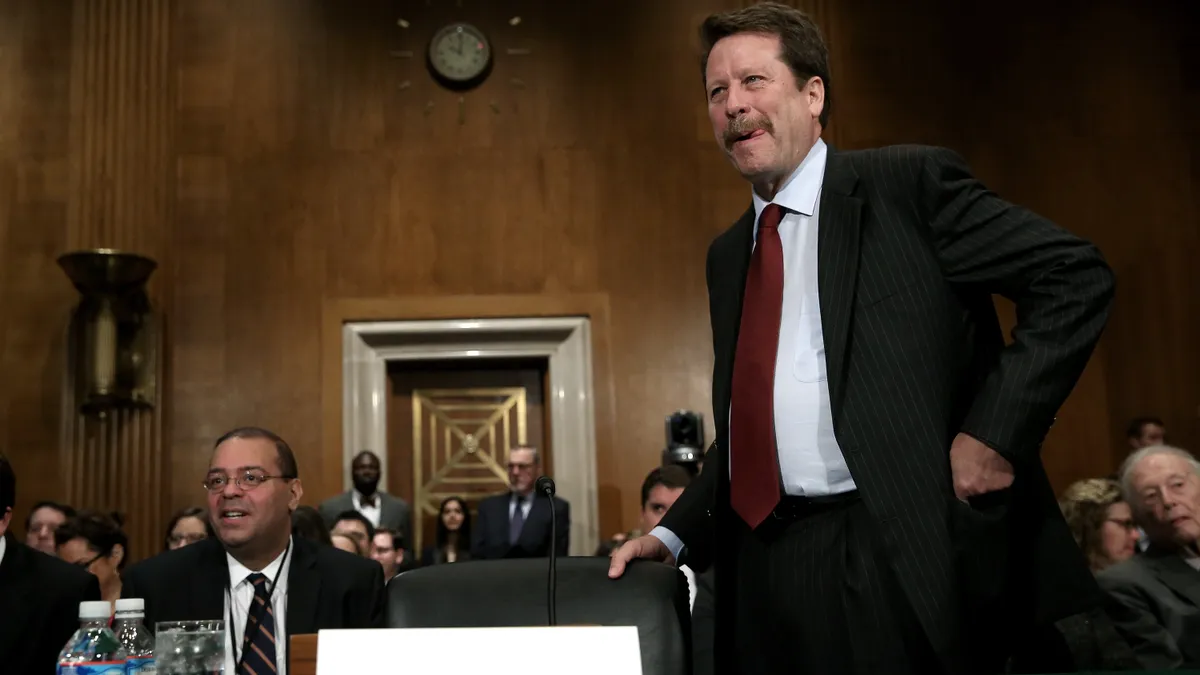Dr. Robert Califf officially notched the first year of his second term as FDA commissioner this week. To celebrate, he’s keeping his eye on solving the agency’s next big challenges, including concerns over advisory committees, digital technology, and potential consequences of new drug pricing measures.
“I didn’t come back at age 71 to kick the can down the road,” he said during a fireside chat last week hosted by the Alliance for a Stronger FDA, a nonprofit coalition that brings together health, food, tobacco and cosmetic industry stakeholders. “As hard as it may be and as much criticism as it may engender, we are going to take on these issues.”
The 21st Century Cures Act, enacted in 2016, gave a “shot in the arm” to the FDA’s medical products division and the regulatory antidote is working to accelerate drug development, Califf argued. For one thing, it has allowed FDA to develop new expedited review pathways for certain drugs and better coordinate regulations in disease areas like cancer. Although “performance could always be better” in the FDA’s drug division, he suggested the agency is likely to deprioritize making further efficiency-focused reforms to those operations and shift focus to other regulated industries where similar reform efforts have dragged.
“I love the medical product side … it has gotten a lot of attention, we need to do a lot of work on the other side of the house,” Califf said during the meeting. “Unevenness (between divisions) is something we’re really dealing with.”
And while FDA officials have previously highlighted a need for more funding to drive these changes, this time around Califf said “that to make the case for dollars” FDA must “clean up (its) own kitchen.”
Still, even with a de-emphasis on drugs, Califf reaffirmed the FDA’s commitment to address a slew of pressing issues facing drug developers over the next two years of the Biden administration. Here’s a look at what he had to say.
Advisory committees
“Advisory committees are an area where we need to do a lot of work. I’ve come to think of many things in government like artificial intelligence algorithms, if you develop one and you just leave it in place, it deteriorates over time.”

Several controversial FDA drug approvals over the last few years have brought increased public scrutiny to the agency’s advisory committees, and Califf said the agency is looking into ways to improve the committee processes.
Disagreements between advisory committees and the FDA over drug approval decisions is a natural part of the process: “It’s like democracy, it’s messy,” Califf said, arguing that one of the largest challenges with the committees is finding qualified experts to serve on them.
“Show me an expert in a rare disease who’s not spending time working on therapeutics for that disease and then you automatically have what is traditionally considered a conflict,” he said.
However, during a hearing of the House Energy and Commerce Subcommittee on Health last week he highlighted a commitment to “optimize the use of advisory committees” to better “meld together” the patient, general medicine and expert perspectives.
Drug pricing
“The IRA is a big law. There will be unanticipated consequences. There will be repair work that will need to be done to make it right. So, we’re all going to watch with interest and try things.”

The CMS might be charged with implementing drug pricing reforms enacted under the Inflation Reduction Act, but the FDA is closely monitoring how the changes could impact future drug approvals, Califf said.
Notably, he hinted at the potential for regulatory and legislative efforts to tune up the law, particularly because of the way the timeline for negotiations (nine years after launch for small molecule drugs compared to 13 years for biologics) could incentivize biologic drug manufacturing.
“I can’t stress how important I think understanding what the incentives are doing on the medical products side is — we really just can’t ignore the impact of incentives. But it gets tough because once something is incentivized, it is hard to stop incentivizing it,” he said. “I hope the government can respond.”
In the meantime, Califf also said FDA is ramping up communication with CMS, and is even lending staff “as they’re trying to figure out how to implement the IRA.”
The end of COVID-19 protections
“If there’s a useful product out there that has an EUA, whether it’s a drug, device, vaccine or diagnostic test, it's going to be EUA’d until it can be converted to a regular approval.”

All federal COVID-19 public health emergency declarations, which gave the FDA increased authority to authorize medical countermeasures, are expected to end in May after being in place for over three years.
Califf reassured stakeholders that the FDA has some flexibility to keep emergency use authorization pathways open after the public health emergency ends. As for drugs that are currently under EUA status, FDA expects to examine their efficacy and either approve or deny them under normal pathways.
“There are some (drugs) that were EUA’d that will turn out to not be so good when all of the data comes in, so that will be evaluated too,” Califf said.
Drugmakers can expect further guidance documents and federal register notices over the coming months as these changes take shape.
A digital revolution
“Having a data platform that gives you the information you need to be smart is something that we really, really need to think through and work on.”

Between his stints at the FDA, Califf served as head of strategy and policy at Google Health, which he said has informed his eagerness to improve the FDA’s internal digital practices as well as its regulation of emerging technology, including AI.
“ChatGPT is an example, and all of the Big Tech companies have comparable technology. It is going to change a lot of the fundamental operations of diagnosis and treatment and clinic visits and all of those things,” he said during the fireside chat.
To aid in these efforts, FDA last week hired Troy Tazbaz, a former executive at Oracle, who will lead the Digital Health Center of Excellence and regulate emerging digital technologies popping up in all stages of drug development.
Califf also said he’s focused on better configuring FDA’s internal data systems to respond more quickly to industry needs and said the federal government’s classic “incremental” approach should be rethought to evolve the tech infrastructure.
The new normal
“We’re now not thinking about COVID as the driver of what we do. It’s really (about): What’s the workplace of the future?”

The Centers for Drug Evaluation and Research (CDER) and Biologic Evidence Research (CBER) began in-person meetings this week after a three-year hiatus from the practice during the COVID-19 crisis.
But otherwise, Califf said he expects the agency to maintain its hybrid work model for the long term. Before the pandemic, the FDA already operated in a hybrid model because of a lack of available office space. Now, the benefits of the work-from-home model, including employee satisfaction and the potential to reallocate resources, outweigh any concerns.
“If we can reduce the amount of space we were in, we can hire more people,” Califf said.


















